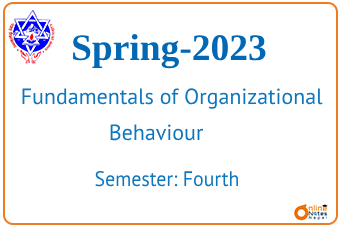Published by: Dikshya
Published date: 03 Sep 2023

POKHARA UNIVERSITY
Level: Bachelor Semester: Spring Year: 2023
Programme: BBA/BI/TT/BCIS/BHCM/BHM Full Marks: 100
Course: Fundamentals of Organizational Behaviour Pass Marks: 45
Time: 3 hrs.
Candidates are required to answer in their own words as far as practicable The figures in the margin indicate full marks.
Section "A"
Very Short Answer Questions
Attempt all the questions. [10×2]
1. Distinguish between open vs. closed systems.
2. Differentiate between Leaders and Managers.
3. What do you mean by availability Bias?
4. Outline any 4 advantages of bureaucratic structure.
5. What do you mean by the learning organization?
6. Define the concept of filtering in communication.
7. Distinguish between functional vs. dysfunctional conflict
8. Explain the term worker obsolescence.
9. Differentiate between intrinsic vs. extrinsic motivation.
10. Describe the term Narcissism.
Section "B"
Descriptive Answer Questions
Attempt any six questions. [6×10]
11. Define organizational behaviour. Why is the study of organizational behavior essential for all managers? Explain.
12. Define perception. Why do people perceive things differently? Explain the factors that influence our perception.
13. Why some teams are more effective than others? What are the major components for building an effective team? Explain.
14. How does a leader influence the behaviours of followers toward goal achievement? Explain with reference to the path-goal theory of leadership.
15. What are the major factors that cause organizational stress? Discuss how this organizational stress can be managed.
16. How your communication travelled with your intended audiences? Explain with considering the major components in the communication process.
17. Why changes are needed in an organization? Describe Lewin's three step model of social change in brief.
Section "C
Case Analysis
18. Read the case situation given below and answer the questions that follow: [20]
Wal-Mart Stores
One of the most successful department stores in America is known as Wal-Mart Store and is named after its founder Sam Walton. Because of the phenomenal Success of these stores, Sam Walton became the richest man in America. Also because of his leadership, the stores have enjoyed continuous growth and expansion, so that by the mid 1980s, the chain had over 700 stores and was increasing at the rate of an additional 100 stores per year. Its sales increased annually by over 35% per year and the profits have soared close to 40% per year every year since 1975.
Sam Walton, until he died in 1992, took personal interest in his employees. His managerial philosophy was to get the right people at the right places and then give them the freedom to be innovative to accomplish their tasks. He called the employees as associates and treated them as associates. As per company policy, all associates are eligible for-profit sharing plans, which motivate the employees further. The managers of the stores are required and encouraged to meet with their employees in a social setting to discuss their concerns as well as issues of organizational interest, and this makes the employees feel that their input is taken seriously by the management..
Sam Walton himself led a simple life. He did not exhibit any aura about himself, giving employees a feeling that he was one of them. He and his executives regularly travelled in company owned planes to visit Wal-Mart stores situated at various sites across the country. He met with sales clerks. stock clerks, stock boys and sales managers to find out what items were popular. He knew most of them by their first names and addressed them so.. He initiated "employee of the month" in all categories and created honor roles for more successful stores. This created inner competition requiring extra effort to improve the sales and services. This policy gained high respect for him as a leader.
The administration of the organization is very cost conscious. It only spends about 2% of sales for general administrative expenses. It shops for suppliers at bargain prices all around the world and has built giant warehouses around the country in such a manner so that most stores are within six hours of driving distance from a warehouse. This helps in better delivery systems and reduced inventories at retail stores. Each store prepares a monthly financial report which can be studied line by line to look for ways to reduce cost further. These cost savings are passed on to the customers and this in turn generates customer loyalty. Wal-Mart's slogan of "quality you need, prices you want" has become a generic organizational statement.
Wal-Mart with more than 2000 stores at present is faced with tough competition from a similar chain of discount stores known as K-Mart. However, Sam Walton did not worry about the competition because he felt that his people-oriented philosophy of operations and cost cutting efforts without diluting the quality of the merchandise would always meet the competition head-on.
a) How would you describe Sam Walton as an effective leader? What leadership theory is consistent with his leadership style?
b) What factors, other than the leadership style, contributed towards the survival and the growth of the organization? Support your reasons.